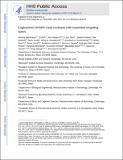| dc.contributor.author | Nishimasu, Hiroshi | |
| dc.contributor.author | Shi, Xi | |
| dc.contributor.author | Ishiguro, Soh | |
| dc.contributor.author | Gao, Linyi | |
| dc.contributor.author | Hirano, Seiichi | |
| dc.contributor.author | Okazaki, Sae | |
| dc.contributor.author | Noda, Taichi | |
| dc.contributor.author | Abudayyeh, Omar O. | |
| dc.contributor.author | Gootenberg, Jonathan S | |
| dc.contributor.author | Mori, Hideto | |
| dc.contributor.author | Oura, Seiya | |
| dc.contributor.author | Holmes, Benjamin Ray | |
| dc.contributor.author | Tanaka, Mamoru | |
| dc.contributor.author | Seki, Motoaki | |
| dc.contributor.author | Hirano, Hisato | |
| dc.contributor.author | Aburatani, Hiroyuki | |
| dc.contributor.author | Ishitani, Ryuichiro | |
| dc.contributor.author | Ikawa, Masahito | |
| dc.contributor.author | Yachie, Nozomu | |
| dc.contributor.author | Zhang, Feng | |
| dc.contributor.author | Nureki, Osamu | |
| dc.contributor.author | Zhang, Feng | |
| dc.date.accessioned | 2020-07-27T15:31:13Z | |
| dc.date.available | 2020-07-27T15:31:13Z | |
| dc.date.issued | 2018-08 | |
| dc.date.submitted | 2018-01 | |
| dc.identifier.issn | 0036-8075 | |
| dc.identifier.issn | 1095-9203 | |
| dc.identifier.uri | https://hdl.handle.net/1721.1/126396 | |
| dc.description.abstract | The RNA-guided endonuclease Cas9 cleaves its target DNA and is a powerful genome-editing tool. However, the widely used Streptococcus pyogenes Cas9 enzyme (SpCas9) requires an NGG protospacer adjacent motif (PAM) for target recognition, thereby restricting the targetable genomic loci. Here, we report a rationally engineered SpCas9 variant (SpCas9-NG) that can recognize relaxed NG PAMs. The crystal structure revealed that the loss of the base-specific interaction with the third G is compensated by newly introduced non-base-specific interactions, enabling the NG PAM recognition. We showed that SpCas9-NG induces indels at endogenous target sites bearing NG PAMs in human cells. Furthermore, we found that the fusion of SpCas9-NG and the activation-induced cytidine deaminase (AID) mediates the C-to-T conversion at target sites with NG PAMs in human cells. | en_US |
| dc.description.sponsorship | NICHD (Grants P01HD087157, R01HD088412) | en_US |
| dc.description.sponsorship | NIMH (Grants 5DP1-MH100706,1R01-MH110049) | en_US |
| dc.description.sponsorship | NIDDK (Grant 5R01DK097768-03) | en_US |
| dc.language.iso | en | |
| dc.publisher | American Association for the Advancement of Science (AAAS) | en_US |
| dc.relation.isversionof | http://dx.doi.org/10.1126/science.aas9129 | en_US |
| dc.rights | Creative Commons Attribution-Noncommercial-Share Alike | en_US |
| dc.rights.uri | http://creativecommons.org/licenses/by-nc-sa/4.0/ | en_US |
| dc.source | PMC | en_US |
| dc.title | Engineered CRISPR-Cas9 nuclease with expanded targeting space | en_US |
| dc.type | Article | en_US |
| dc.identifier.citation | Nishimasu, Hiroshi et al. "Engineered CRISPR-Cas9 nuclease with expanded targeting space." Science 361, 6408 (August 2018): 1259-1262 © The Authors | en_US |
| dc.contributor.department | Massachusetts Institute of Technology. Department of Biological Engineering | en_US |
| dc.contributor.department | Massachusetts Institute of Technology. Department of Brain and Cognitive Sciences | en_US |
| dc.contributor.department | McGovern Institute for Brain Research at MIT | en_US |
| dc.contributor.department | Broad Institute of MIT and Harvard | en_US |
| dc.relation.journal | Science | en_US |
| dc.eprint.version | Author's final manuscript | en_US |
| dc.type.uri | http://purl.org/eprint/type/JournalArticle | en_US |
| eprint.status | http://purl.org/eprint/status/PeerReviewed | en_US |
| dc.date.updated | 2019-10-08T13:02:02Z | |
| dspace.date.submission | 2019-10-08T13:02:04Z | |
| mit.journal.volume | 361 | en_US |
| mit.journal.issue | 6408 | en_US |
| mit.metadata.status | Complete | |
